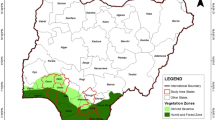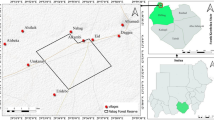Abstract
The Conversion of Cropland to Forest and Grassland Program (CCFG), which was initiated by the Chinese government in 1999, is a cropland retirement program with integrated objectives for ecological preservation and local development. The purpose of this article was to study the influencing factors of attitude and economic strategies in rural households toward the CCFG. Rural households’ knowledge, attitude and economic strategies toward the CCFG were investigated through a questionnaire survey in Qira, China. Influencing factors of attitude and strategies of households were analyzed using a logit model technique. The analysis indicated that household’s income level, environmental knowledge of the program, and program implementation were significant influencing factors in a household’s attitude toward the CCFG, while major influencing factors of household strategies were their regional background and availability of income generation sources. Meaningful association was not found between attitude and strategy choices. Rich households had more strategy choices, while poor households were usually confined to low input strategies with uncertain income. To sustain their livelihood, the poor need extra assistances in marketing, loan granting, employment training, information, and technical services.

Similar content being viewed by others
References
Ap J (1992) Residents’ perceptions on tourism impacts. Annals of Tourism Research 19(4):665–690
Chen G, Li R, Yang Q, Wang G (2004) Influence of removal lands from cultivation to afforestation and grass planting on rural social economy in Loess Hilly-Gully Region in North Shaanxi: a case study on Xiannangou Watershed and Yangou Watershed. Science of Soil and Water Conservation 2(4):48–52
Demurger S, Fournier M, Shen G (2005) Forest protection policies, national guidelines and their local implementation in north Sichuan. China Perspectives 59:2–13
Fan X, Mi W, Yang M (2005) Discussion on compensation of ecosystem for returning farming to forest and grassland in the mountain area of Southern Ningxia. Research of Soil and Water Conservation 12(2):174–177
Li H, Yao S, Guo Y (2006) Impact study on of Conversion of Cropland to Forest and Grassland Program on households’ economic behaviors. China Population, Resources and Environment: Special issue for Annual Symposium of China Society for Sustainable Development, theme 5:1062–1067
Lian G, Guo X, Fu B et al (2005) Farmer’s perception and response towards Grain for Green program and eco-environment based on participatory rural appraisal. Acta Ecologica Sinica 25(7):1741–1747
Mi W, Liu X, Wang Y (2005) Study on following industry of converting slope cropland to woodland and grassland in southern mountain in Ningxia. Research of Soil and Water Conservation 12(1):91–94
Uchida E, Xu J, Xu Z, Rozelle S (2004) Are the poor benefiting from China’s conservation set-aside program? Working paper. University of California, Davis
Uchida E, Xu J, Rozelle S (2005) Grain for Green: cost-effectiveness and sustainability of China’s conservation set-aside program. Land Economics 81(2):247–264
Wang X (2003) The cropland conversion: contracting out and public regulation. Economic Studies 4:107–116
Weyerhaeuser H, Wilkes A, Kahrl F (2005) Local impacts and responses to regional forest conservation and rehabilitation programs in China’s northwest Yunnan province. Agricultural Systems 85:234–253
Xu Z, Bennett MT, Tao R, Xu J (2005) China’s Sloping Land Conversion Program four years on: current situation, pending issues. FED Working Papers Series, No. FE20050016. www.fed.org.cn
Xu J, Katsigris E, White TA (eds) (2002) Implementing the natural forest protection program and the sloping land conversion program: lessons and policy implications. CCICED-WCFGTF, Beijing
Xu Z, Xu J, Deng X, Huang J, Uchida E, Rozelle S (2005b) Grain for Green versus Grain: conflict between food security and conservation set-aside in China. World Development 34(1):130–148
Xu J, Yin R, Li Z, Liu C (2006) China’s ecological rehabilitation: unprecedented efforts, dramatic impacts, and requisite policies. Ecological Economics 57(4):595–607
Zhai W, Huang X (2005) Application of data envelopment analysis in evaluating farmers’ responses to the conversion of household cultivated land to forest or grass land. Resources and Environment in the Yangtze Basin 14(2):198–203
Zhang S, Zhu S, Tao W, Wu D, Zhai G, Xie X, Kontoleon A, Groom B et al (2005) Impacts of compensation policies in reforestation programs—case study 1: assessing the impacts of the Sloping Land Conversion Program on local community welfare. Working Report for CCICED
Zuo T (2002) Implementation of the SLCP. Implementing the natural forest protection program and the sloping land conversion program: lessons and policy implications. CCICED-WCFGTF, Beijing
Acknowledgments
This research was supported by Major State Basic Research Development Program of China (Grant No. 2007CB407307).
Author information
Authors and Affiliations
Corresponding author
Rights and permissions
About this article
Cite this article
Ma, H., Lu, Y., Xing, Y. et al. Rural Households’ Attitude and Economic Strategies Toward the Conversion of Cropland to Forest and Grassland Program (CCFG): A Case Study in Qira, China. Environmental Management 43, 1039–1047 (2009). https://doi.org/10.1007/s00267-009-9290-z
Received:
Revised:
Accepted:
Published:
Issue Date:
DOI: https://doi.org/10.1007/s00267-009-9290-z




